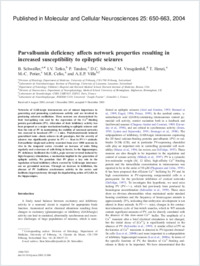Parvalbumin deficiency affects network properties resulting in increased susceptibility to epileptic seizures
- Schwaller, Beat Division of Histology, Department of Medicine, University of Fribourg, Switzerland
- Tetko, I. V. Laboratoire de Neuroheuristique, Institute of Physiology, University of Lausanne, Switzerland
- Tandon, P. Department of Neurology, Children's Hospital and Harvard Medical School, Harvard Institute of Medicine, Boston, USA
- Silveira, D. C. Department of Neurology, Children's Hospital and Harvard Medical School, Harvard Institute of Medicine, Boston, USA
- Vreugdenhil, M. Division of Neuroscience, Department of Neurophysiology, Medical School, University of Birmingham, Edgbaston, Birmingham, UK
- Henzi, Thomas Division of Histology, Department of Medicine, University of Fribourg, Switzerland
- Potier, M. -C. Laboratoire de Neurobiologie, CNRS UMR7637, ESPCI, Paris, France
- Celio, Marco R. Division of Histology, Department of Medicine, University of Fribourg, Switzerland
- Villa, A. E. P. Laboratoire de Neuroheuristique, Institute of Physiology, University of Lausanne, Switzerland - Laboratoire de Neurobiophysique, INSERM U318, Université "Joseph Fourier", Grenoble, France
-
21.02.2004
Published in:
- Molecular and Cellular Neuroscience. - 2004, vol. 25, no. 4, p. 650-663
English
Networks of GABAergic interneurons are of utmost importance in generating and promoting synchronous activity and are involved in producing coherent oscillations. These neurons are characterized by their fast-spiking rate and by the expression of the Ca2+-binding protein parvalbumin (PV). Alteration of their inhibitory activity has been proposed as a major mechanism leading to epileptic seizures and thus the role of PV in maintaining the stability of neuronal networks was assessed in knockout (PV−/−) mice. Pentylenetetrazole induced generalized tonic–clonic seizures in all genotypes, but the severity of seizures was significantly greater in PV−/− than in PV+/+ animals. Extracellular single-unit activity recorded from over 1000 neurons in vivo in the temporal cortex revealed an increase of units firing regularly and a decrease of cells firing in bursts. In the hippocampus, PV deficiency facilitated the GABAAergic current reversal induced by high-frequency stimulation, a mechanism implied in the generation of epileptic activity. We postulate that PV plays a key role in the regulation of local inhibitory effects exerted by GABAergic interneurons on pyramidal neurons. Through an increase in inhibition, the absence of PV facilitates synchronous activity in the cortex and facilitates hypersynchrony through the depolarizing action of GABA in the hippocampus.
- Faculty
- Faculté des sciences et de médecine
- Department
- Département de Médecine
- Language
-
- English
- Classification
- Biological sciences
- License
-
License undefined
- Identifiers
-
- RERO DOC 4328
- DOI 10.1016/j.mcn.2003.12.006
- Persistent URL
- https://folia.unifr.ch/unifr/documents/299739
Statistics
Document views: 183
File downloads:
- Texte intégral: 477
